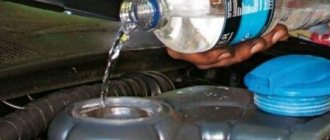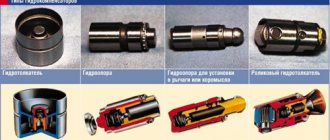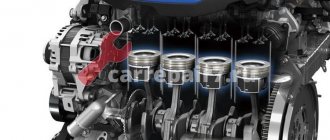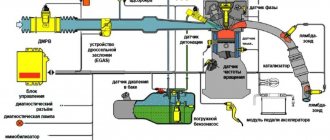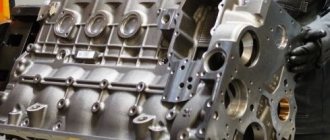Do I need to warm up the engine before driving?
Today there is a lot of controversy about this, but no consensus has emerged on this matter.
Even 15–20 years ago, the answer to the question was clear: yes, it is necessary to warm up the engine. And both in winter and in summer. Unheated cars sneezed, coughed, stalled, or refused to start at all.
But with the advent of more modern cars, motorists en masse refuse to warm up the engine. Moreover: in many European countries, warming up the engine while parked is strictly prohibited by law.
As we all know, the power plant of a car is a kind of its heart, the service life of which directly depends on a large number of indicators, frequency of maintenance and operating rules. Today’s topic is dedicated to those car enthusiasts who don’t know what to do before starting to drive their car, whether it’s worth warming up the engine and how long it should take? For reference, we note that today the number of supporters and opponents of engine warming up is almost equal. Some people refer to the technical documentation for the car, while others adhere to the old-fashioned rules for operating the car. Who is right in this situation? What is the right thing to do so as not to harm the car engine? We will analyze these questions in our article in order to forever remember how competently you need to start a train in your car in winter, as well as in summer.
Most modern automakers have increasingly begun to indicate in the vehicle manual that there is no need to warm up the engine, and that all engines now do not require this procedure. In addition, manufacturers believe that warming up the power plant is just unnecessary fuel consumption and environmental pollution, because engines emit exhaust gases into the atmosphere, which lead to greenhouse effects, as well as the appearance of ozone holes. But is it
? That is, it turns out that if we want to start a trip in twenty-degree frost, we don’t need to warm up the engine even for the same 30 seconds? Can motor oil really immediately become optimally viscous and turn from thick to liquid, which will be suitable for driving? However, as a rule, there are simply no clear answers to these questions in the documentation for the car. It only says that we need to take care of the environment, “our mother.”
For reference, we note that if we buy a car in Europe (starting from Poland, the Baltic states and further west), in the technical documentation for the car there will be a sign of crossed out exhaust gases, which indicates concern for the environment, that is, heating the engine is evil for nature . However, as we noted earlier, why didn’t anyone think about the engine, but is it good or bad? To find out, we must analyze the positive and negative aspects that exist for the power plant from warming up.
Is it necessary to warm up the engine in summer? - the expert puts an end to it!
“Everyone is free to do whatever they want with their car. Fill it with 80, don’t warm it up, drive in 3rd gear all day. The main thing is to put on shiny wheels!”
From the “Behind the Wheel” forum
Is it necessary to warm up a modern engine?
The popularity of this issue has been unparalleled for many years. Experienced engineers, tired of debunking myths, wearily nod their heads - they say, it’s necessary. But omniscient bloggers, on the contrary, contemptuously hint at old-fashioned insanity and refer to high modern technologies. Note that we are talking about winter operation of the car - it never occurs to anyone to argue about warming up in warm weather.
But in vain!
Unbearable morning exercises
To be honest, I will note that I practically do not warm up the engine in the summer. However, I never lose it right off the bat, because every time I automatically remember how disgusting it is to do morning exercises. I assure you that the car experiences similar emotions.
Engine oil:
It is the most important technical fluid of any car, which ensures optimal lubrication of rubbing parts in the power plant. However, in order for the oil to perform its main functions, it must be in a liquid and heated state. When we turn off the engine, the oil always flows into the sump and remains there until the next time the engine is started. Thus, the technical fluid drains from the walls of the parts, leaving their surface almost dry.
In connection with the above, we note that when we start the engine, it is highly not recommended to even lightly press the gas pedal for at least 10-15 seconds, not to mention starting to move. The fact is that in the first seconds after starting the engine, oil begins to rise through the channels from the sump to the top of the system, thereby filling all the cavities of the power plant in order to effectively lubricate the cylinder-piston group ( pistons
,
cylinders
,
camshaft
,
crankshaft
,
valves
and other elements).
If we consider the winter season, the situation here is even more complicated for oil, since under the influence of low temperatures, the liquid becomes thick. In order for the oil to become liquid, a positive temperature is necessary. And without heating the engine there is no way to achieve this. So much for caring for nature. For reference, we note that thick oil is similar in consistency to glue and if it is not heated, the wear of engine components will occur at an accelerated pace, since the lubrication of parts will not occur effectively.
Engine warm-up temperature and time
If we talk about the warm season, then a couple of minutes of idling will be enough for a fuel-injected car or diesel engine. Carburetor engines need to be warmed up for 7-8 minutes. Then you can start driving in lower gears and low revs (about 2000 for a gasoline car and 1200 for a diesel vehicle). In winter the situation changes.
Gasoline engines
If your engine has a carburetor, then it needs to be warmed up for at least 15 minutes. In severe frost this time may be increased. The main task is to warm up until the engine runs stably when you press the gas pedal and increase the fuel supply. Carburetor engines must be heated to 40 degrees or more before driving, guided by a special mark on the temperature scale.
The minimum warm-up time for an injection gasoline engine can be considered to be about 5 minutes. During warm-up, you need to monitor the tachometer, since after starting a cold internal combustion engine, the idle speed is usually overestimated by the ECU. As the temperature rises, the tachometer needle will drop to 750-900 rpm, after which you can start driving.
Warming up the engine with HBO
The presence of gas equipment up to the 4th generation, where the choice of fuel type is carried out manually, obliges drivers to adhere to certain rules. It is recommended to start the engine and its subsequent warming up strictly on gasoline.
In winter, it is advisable to use gasoline until the internal combustion engine reaches operating temperatures, after which it switches to gas. If there are no severe frosts, then the minimum temperature for warming up the engine before switching to gas is about 50 degrees Celsius. Ignoring these rules can quickly damage the LPG gearbox, and running a cold engine on gas has a negative impact on the service life of the power plant.
How to warm up a diesel
Winter warming up of a diesel engine at idle for 5-10 minutes is also necessary, although the temperature of engines of this type rises more slowly compared to their gasoline counterparts.
Please note that you do not need to wait for the temperature gauge to start rising before starting your trip. After warming up at idle, a diesel car is usually warmed up while driving.
In this case, the diesel engine starts using the remaining diesel fuel, while fresh fuel is not supplied due to clogging of the fuel filter with paraffin, etc. Taking into account this feature, the right solution in winter would be to warm up the diesel engine for about 10 minutes, which will ensure normal fluidity and a stable supply of diesel fuel to the engine without the risk of stalling at a busy intersection.
Why is it better to warm up the engine before driving: lubrication, fuel, wear of cold parts. How to properly warm up a diesel engine in winter.
How to add oil to the engine correctly. Topping up “on a cold one”, adding lubricant to a hot engine. What oil can be used for topping up, useful tips.
The engine warms up slowly at idle or while driving: why does this happen? Possible malfunctions of the cooling system, other reasons.
To warm up or not to warm up the engine in winter before driving. Why the engine should be warmed up, how to properly warm up the engine before driving and while driving.
The engine temperature does not rise, the internal combustion engine temperature needle drops while driving. Why does the temperature drop after turning on the stove? Diagnostics and repair, advice.
The main reasons why the engine starts to stall after warming up. Frequent problems of carburetor and injection engines, fault diagnosis.
Source
Compression and oil scraper rings
These elements of the power plant are located in special grooves on the pistons. Oil scraper rings are needed to remove excess oil from the cylinder walls, and compression elements are needed for compression. These two types of rings are located next to each other. The rings are rubbing parts; their friction occurs against the surface of the cylinder. In addition, they take on powerful impact loads. Now it’s worth remembering my school years and a subject called physics. It says there that all metal parts expand when heated. As for the engine, the same cylinder block is made of metal, therefore the cylinders located in it expand by several microns when heated, and when cooled they narrow back by the same amount.
Thus, when the power plant is not warmed up, the cylinders compress the rings more strongly. When the engine starts, it becomes more difficult for the rings in this state to move up and down the plane of the cylinder. After the inner surface of the cylinder block is heated, the metal expands and the oil thereby begins to lubricate the cavity with the parts much more effectively, so the movement of the rubbing elements becomes easier.
Therefore, immediately after starting, the engine initially increases speed, and then after a short time interval it smoothly reduces it. When the speed of the power plant decreases, this indicates that the surface of the cylinders and parts has been brought to a heated state. Consequently, it becomes easier for the motor to work, the load on it gradually decreases. Thus, the situation described above is another reason to warm up the power unit. Thanks to warming up, we seem to unload and remove excessive load from the cylinder-piston group.
Oil filter
Just like the previously described units, they need to be warmed up, especially in the winter months. The fact is that the oil filter only at first glance seems to be a simple consumable item, which consists of special paper wrapped in a metal case, but this is deeply misleading. In the case when engine oil passes through a good filter, then all the dirt that is present in the technical fluid remains in the filter element. This cleanses the oil, which continues to circulate through the engine system. Thus, all metal shavings with wear elements settle on the filter paper and do not pass further.
When the engine is not warmed up, the oil becomes thick and simply cannot pass through the filter paper of the consumable element properly. Therefore, when the car is moving with a cold engine, a bypass valve opens in the filter and the technical fluid, bypassing the filter element, is sent from the pan directly to the engine, carrying wear products. For reference, we note that engine oil becomes liquid only after the power plant warms up to 65-70 degrees Celsius. At this temperature, the technical fluid is able to optimally penetrate the filter paper and thus the bypass valve does not open. Thus, cold oil with dirt goes directly into the engine, and by starting a trip without warming up, we simply accelerate the wear of our engine.
Possible problems when operating a cold engine
The vehicle's technical operating manual, issued by the manufacturer, does not always contain up-to-date information for the region where the vehicle is operated. There are many foreign cars sold in Russia, but technical literature on them is not always adapted to the realities of our country. Without warming up the engine before driving, the driver runs the risk of bringing the need for major engine repairs as soon as possible. Let's take a closer look at why it is necessary to warm up the engine before driving.
Engine oil temperature
Every driver knows that the oil needs to be changed promptly, but not everyone understands how the lubricant acts in the engine. While the engine is running, oil “runs” through it, like blood through the human body. When the engine stops, the oil flows into the pan, and only a small oil film remains on the engine elements. The longer the engine does not start, the thinner this film is, and the more dangerous it is to go on a trip without warming up the engine.
In the warm season, for engine oil to disperse through the channels after starting the engine and begin to do its job, it takes about 30 seconds. Therefore, you cannot go on a trip in the first 30 seconds after starting the engine, even in summer. In winter, the situation is aggravated, since during downtime the oil becomes thick due to the low temperature, and it requires additional time to go through the full lubrication cycle and reach operating temperature.
If you do not warm up the engine oil, not only does wear increase, but there is also a high risk of critical failure of the engine unit, which will require immediate repair.
Oil filter operation
To trap carbon microparticles, chips, and other debris accumulated in the engine oil, a filter is installed in the car. The main working area of the filter is paper with micropores through which oil passes. The paper traps debris, and the less viscous the oil, the easier it is for it to pass through the filter.
When the engine oil cannot pass through the filter element, the bypass valve opens and the oil is sent unfiltered to the engine. Thus, dirt enters the engine, and if you start driving the car at this moment, the wear of the engine components will be maximum.
Warming up the engine for good oil flow is necessary both in warm and cold seasons. At temperatures below minus 10 degrees Celsius, it is recommended to warm up the car for at least 10 minutes so that the oil becomes less viscous and filters well.
Oil scraper and compression rings
If you start driving the car on a cold engine, there is a high risk of damage to the oil scraper and compression rings located on the piston grooves. As you know, rings are installed in the engine to remove excess oil and create compression. During operation, they are subject to serious loads as they rub against the cylinder walls.
Many drivers have noticed that within a few seconds after the engine starts, it operates at high speeds, which drop after some time. This is due precisely to the stroke of the engine cylinders. When heated, the cylinders, like any metal, expand by several microns, due to which the rings are released from compression. At the same moment, the engine elements begin to be more efficiently lubricated.
Without warming up the engine cylinders before starting, the driver risks damaging not only the rings, but also the cylinders.
Hydraulic compensators and hydraulic tensioners
The operation of the engine valves of modern cars is corrected by hydraulic compensators and hydraulic tensioners, which are necessary for tensioning the chain. To operate, oil must be pumped into the elements, which occurs after it has warmed up to operating temperature. If you start driving the car without warming up the lubricant, the gaps will be adjusted with little efficiency.
Oil sensor failure
A pressing problem for modern cars is the failure of oil sensors when the engine is not warmed up. Plastic sensors under the pressure of thick oil are damaged if you start driving, and the car begins to signal a lack of lubricating fluid in the sump.
This problem is relevant for machines in which oil sensors are installed in a plastic housing. If the element is made mostly of metal, the malfunction may not be observed.
Hydraulic tensioner and hydraulic compensators
Used to adjust valve operation and chain tension. These devices are designed to pump engine oil into the system and ensure optimal tension of the drive chain of the gas distribution mechanism, that is, they align the operation of the valves. When unheated oil enters the engine, adjustment of the required clearances in the system is not carried out effectively. Therefore, the engine must be warmed up so that the oil becomes elastic and fluid. This problem is especially noticeable in severe frost, because the chain begins to rattle and the valves begin to tap. In general, there’s nothing to even think about here; it’s better to warm up the engine than to run into a situation where the chain jumps over a gear tooth, which will lead to expensive engine repairs.
How to warm up your car correctly
Drivers are divided into two types. Some warm up, others don't. Both of them have arguments. Let's find out: do you still need to warm it up? And how to do it right?
The arguments in favor of warming up are clear: you need to warm up the oil in the engine and gearbox so that it works better. Cold oil is thick, viscous, and does not lubricate parts well. Better lubrication means less friction, less friction means the motor and gearbox last longer.
At the same time, they warm up differently. Some people consider the engine temperature to be 50 degrees, at which you can start driving. I've heard advice that you need to warm it up to operating temperature (about 90 degrees depending on the machine)!
I decided to figure it out. Since I drive a Lada Grant, I’ll tell you using it as an example. Accordingly, the information will primarily concern Lada cars.
Engine oil sensor
For modern cars, it is made of plastic and serves to measure the density of technical fluid in the system. When the engine is not warmed up, the power plant simply squeezes them out due to the thick technical fluid. When the sensor is squeezed out, oil begins to come out from under it and then drip out, which is already a problem for the engine and the car owner. After the oil leaks from the sensor, it begins to signal on the dashboard with a corresponding indicator that the technician has low pressure of the fluid in the sump. Once we start warming up the engine longer, this problem often goes away.
Thus, as we see, driving on a cold car engine does not bring any positive aspects for the components of the power plant. In addition, driving on a “cold” engine can cause increased oil and fuel consumption, and also has a detrimental effect on the environment in the form of carbon dioxide emissions. But the most important problem with systematically not warming up the engine is the rapid wear of engine parts, which quickly leads the power plant to overhaul.
RULES AND RECOMMENDATIONS FOR WARMING UP A CAR ENGINE
Now we know that warming up the engine is not advisable, but mandatory, and this must be done constantly. However, this must be done without fanaticism, since sometimes overheating is worse than warming up. In addition, as we remember, there are two seasons: winter and summer. Regarding this or that couple of years, there are certain engine warm-up modes, which we will now analyze.
For example, in winter, when the outside temperature is from -10 to -20 degrees Celsius, warming up the engine before driving should be done for about 8-12 minutes, this is quite enough. When the outside temperature is from -20 to -30 degrees Celsius, warming up the engine before driving should take about 12-15 minutes, and if we are in a hurry, we can reduce the time period to 10 minutes. The image below clearly shows a reminder to car enthusiasts, which demonstrates the rules for warming up a car in cold weather (CLICK ON IMAGE TO ENLARGE).
As for the summer couple of the year, you should not warm up the engine for more than 5 minutes .
If the outside temperature is
+15-30 degrees
Celsius, then the optimal time for warming up the engine is considered to be
2-3 minutes
, since this is enough for the oil to spread along the cylinder walls and the lubricant to begin functioning fully.
If the outside temperature is above +30 degrees
Celsius, then
1-2 minutes
. Thus, as we can see, even in hot weather it is highly not recommended to start driving the car immediately after starting the engine.
Very often you can hear the assertion of some car enthusiasts that you can start driving a car as soon as the engine speed on the tachometer begins to fall. Yes, indeed, this indicator, to some extent, characterizes the fact that the load on the cylinder-piston group has decreased and the system has warmed up a little. In principle, as specialists in the maintenance and repair of vehicles recommend, regarding the summer couple of the year, you can, in principle, start driving the car. However, this option is not appropriate for winter. In winter, it is better to warm up the engine based on time, not speed. We must understand that during the warm-up of the power plant, not only the cylinders must heat up, but also all the main components of the engine, for example, shafts, connecting rods, pistons, hydraulic compensators and other parts. In addition, we must not forget about the transmission, especially if it is automatic or CVT, since it also needs to be warmed up.
Warming up for cars with automatic transmission
In addition to warming up the engine, it is very important for these vehicles to warm up the transmission and chassis area. When the engine warms up, the oil does not warm up completely, but reaches the required temperature only after traveling a distance of about 30 km. If there is a torque converter in the gearbox mechanism, this problem becomes especially acute.
Therefore, be sure to warm up your machine. To do this, place your foot on the brake pedal and move the lever to position D. The waiting time for this procedure is approximately 4-5 minutes. Do not start driving your car until you have completed the specified engine warm-up algorithm for the automatic transmission.
Find out the meaning of letters and numbers on the automatic transmission box.
How long does it take to warm up the engine?
Perhaps this is the most appropriate question. After all, we have already come to the conclusion that it is necessary to warm up the engine in almost any case. All that remains is to understand how long the warm-up should take.
So, you can follow the hint:
Engine warm-up time in winter and summer
| +15 C | 1 - 2 minutes |
| +10 C | 1.5 - 3 minutes |
| +5 C | 2.5 - 5 minutes |
| 0 C | 3 - 7 minutes |
| -5 C | 3.5 - 8 minutes |
| -10 C | 5 - 10 minutes |
| -15 C | 8 - 15 minutes |
As you can see, in the summer, warming up takes very little time.
You only have time to get comfortable in your seat, fasten your seat belt, adjust the mirrors and turn on your favorite radio channel. In winter, the recommended time for warming up the car is longer, but while your car is warming up, you can slowly clear the snow from the body, clear the wipers of ice, and warm up the windshield.
There is no need to wait until it warms up completely. As soon as the temperature of the working fluid rises to 60-70 degrees, you can carefully start moving. But it would still be more correct to accelerate when the fluid temperature reaches 80-90 degrees Celsius.
How much to heat a car in winter and summer
Warming up the engine is necessary for proper operation, and it’s hard to argue with that. Depending on the ambient temperature, it may take different times to warm up the engine:
- Below -30°C. It is necessary to warm up the engine for 10 to 15 minutes so that the engine oil “warms up” to operating temperature;
- From -10°C to -30°C. You can limit yourself to warming up the engine for 7-10 minutes;
- From +10°C to -10°C. Warming up the car for 4-7 minutes is enough;
- Above +10°C. Warming up for no more than 1-3 minutes is required for the engine oil to disperse throughout the engine and reach operating temperature.
In foreign countries, where most foreign cars are produced and for which instructions are drawn up, the temperature rarely drops below –10°C. That is why manufacturers do not recommend warming up the engine before driving, thereby noting that a couple of minutes of engine operation is enough for the oil to spread through it and you can start driving. In Russia, where temperatures often drop well below -10°C, operating the engine without pre-warming will result in engine failure.
( 450 votes, average: 4.57 out of 5)
How to soften a car's suspension
How to prepare your car for the summer season
Related Posts
Why can't you warm up the engine for too long?
As we said above, everything needs moderation. It is also impossible to warm up the engine for too long.
The fact is that at low temperatures the fuel mixture evaporates poorly, so a car with electronic fuel injection immediately generates a command to release an additional portion of fuel.
But the car remains in place. And it turns out that at idle, excess gasoline is formed in the combustion chamber. Gasoline, in turn, causes the engine oil to wash out, that is, in fact, it leaves the engine without protection. Gasoline, as we know, is an excellent solvent.
However, if you do not delay warming up, nothing like this happens, and premature engine destruction does not occur.
Warm up on the go
Recently, warming up the engine while driving, that is, in the first minutes of moving the car, has become very popular. You simply pull away smoothly and slowly (at low speeds) drive out of the yard or garage. At the same time, it is desirable that the road be as smooth as possible, because during warm-up jerks and jolts are undesirable.
While driving, the engine warms up faster, but experiences increased loads and consumes more fuel.
This method has one drawback: no matter how you look at it, the movement starts with a cold engine, which means the load on the mechanism is greater (remember the gaps and viscosity of working fluids). In addition, the gearbox also needs preheating, and without it, gearbox parts undergo accelerated wear, the oil wears out faster and produces sediment.
The ideal option: run the engine in idle mode for a couple of minutes (twice as long in winter), and then start moving smoothly at low speeds.
What are the dangers of warming up the engine?
Many people are afraid to warm up the engine due to a number of complications caused by this procedure. The disadvantages of warming up usually include:
- increased gasoline consumption;
- formation of resin deposits on valves;
- washing out oil with gasoline.
Oil leaching is especially dangerous. The piston rings and cylinder walls are primarily affected by this. However, it has been proven that all these shortcomings appear only in cases where there is chronic prolonged warming up of the engine.
During moderate warm-up, nothing happens to the engine that could significantly impair its performance.




